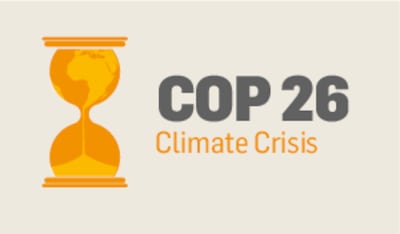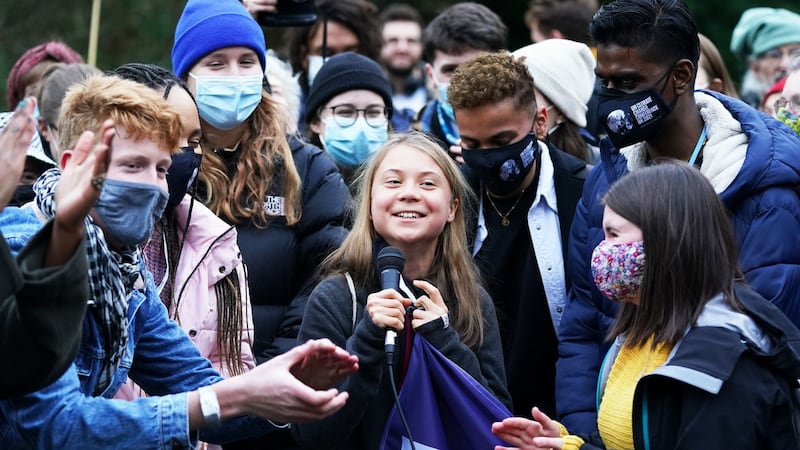On Monday morning at the Cop26 UN Climate Change Conference in Glasgow, Mary Robinson is sitting beneath a huge revolving replica of planet Earth. She lays out the stakes for me: how the world needs to keep within the 1.5 degree temperature increase aspired to five years ago in Paris; how scientific advances have made things far more measurable; and how young activists deserve "action" not "blah, blah, blah". But she also worries because countries like China aren't in attendance and that poorer countries are underrepresented.

“We’re not going to have enough of the real voices, because they can’t get to the Cop. It’s a bit too white and elite, frankly, because of Covid and [because] they didn’t manage the security and the prices.” She’s still optimistic. “I have to be a prisoner of hope.”
Most people I speak to on my first day at Cop26 have Mary Robinson's feeling of worried hope
The Action Hub, in zone B of the Scottish Event Campus, is the bit with the aforementioned globe. There’s a Forest of Promises, which is an artificial tree covered with leaves on which children have written things such as “I promise to use public transport” and “I will use les electrisity”. And there’s an LED tickertape circling the venue to remind everyone where they are and who the partners/sponsors are. The furniture is from Ikea and the television networks have set up studios here. I see Ed Miliband and the actor Mark Strong.
Most people I speak to on my first day at Cop26 have Robinson’s feeling of worried hope. There are an estimated 30,000 attendees, although several thousand of those spend the morning outside queueing in the icy Glasgow cold. That group included Prof Brian Ó Gallachóir and his colleagues from UCC’s Environmental Research Institute, who are here as observers. Like Robinson, he’s conscious of the failure to meet the goals set in Paris, but he also stresses how much good collaborative work gets done in the connections that are made here.
Big screen
We’ve been watching Cop26’s people’s advocate, David Attenborough, deliver his speech on a big screen. Ó Gallachóir notes something Attenborough said about how the countries suffering most from climate change aren’t the ones causing it. His colleague, philosophy lecturer Kian Mintz-Woo, concurs. “Both morally and practically, it’s really important for the western world [to fund] the developing countries to mitigate and adapt. At a symbolic or moral level, it shows that we’re in this together.”
In zone D there is a huge room full of “delegation pavilions” at which various countries, NGOs and companies have demonstrations and talks and, sometimes, free coffee. Prime minister Stefan Löfven is speaking at the Swedish pavilion. The Environmental Defense Fund is promoting a satellite it is launching to monitor methane emissions. Many smaller countries argue for climate justice. At the pavilion of the endangered archipelago of Tuvalu, people are getting selfies with sculptures of polar bears in life jackets and a penguin hanging from a noose.

These are the work of Taiwanese artist Vincent JF Huang. “Sea level is rising. We predict that [there’s] only 20 or 30 more years the Tuvaluans can continue staying on their island. This is quite an urgent situation. Tuvalu was always ignored but I try and use the power of art to help them get more media.” Is it working? He smiles. “You saw a polar bear and you came over.”
Two Swedish girl scouts are being encouraged to create a viral moment by a woman with a phone; “1.5 to stay alive,” coaches the woman, filming it for TikTok. They’re here as observers representing the World Association of Girl Guides and Girl Scouts.
“Our focus is to show politicians and negotiators [that] we young people are affected by their decisions,” says 20-year-old Siri Ankorfor. “I’m a little bit frustrated because due to the pandemic, they’ve banned all observers from all negotiations... We can follow online, but we can’t be in the room. We can’t show our faces to them so they can see who they’re fighting for. I think they forget about that in meetings with only other people like them.”
Humans are actually quite cool and we are really good at fixing things if we work together
Zone F, where all the negotiations are taking place, smells like new carpets and looks like a fancy co-working space. Most here are dressed in sober, well-cut outfits (apart from a few dapper military figures). The space leading to the meetings operates a little like a red carpet, flanked by photographers. At one point a security man guides me gently but firmly out of the path of the fast huddle in which Ursula von der Leyen is travelling. At Cop26 there are two forms of movement. Negotiators walk in packs at speed but everyone else, aware of their mileage, moves more slowly.
At the boundary between zones D and F, there’s a beautiful wooden installation promoting the Eden Project. “A completely destroyed piece of land we turned into a beautiful garden,” explains educator Bran Howell. “Humans are actually quite cool and we are really good at fixing things if we work together... The future’s whatever we want to make. If we can turn this area into something beautiful, then we can do that anywhere in the world.”










